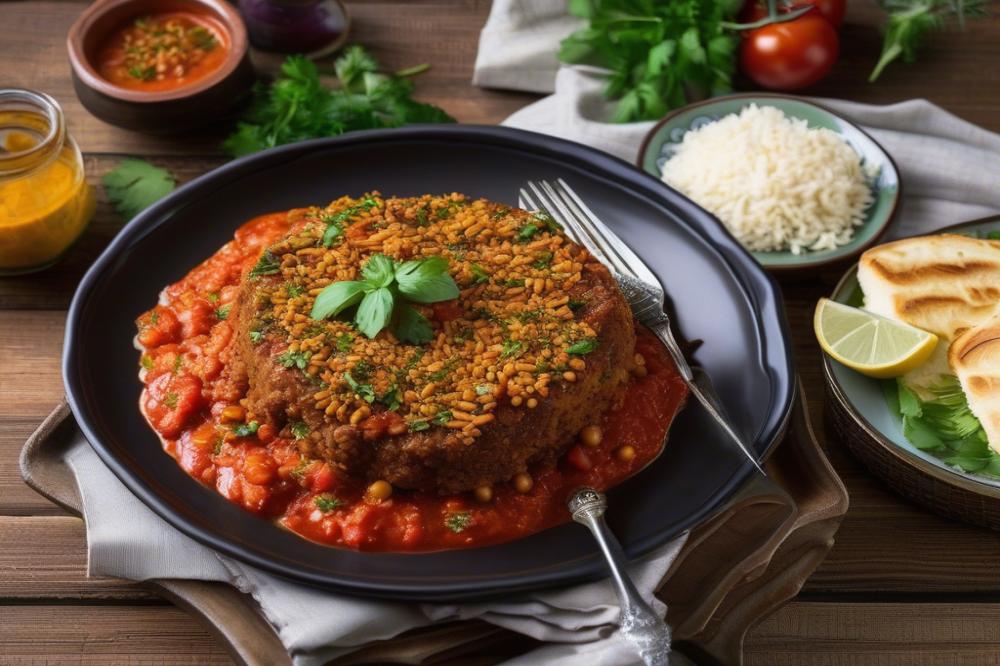The Iconic Moroccan seafood tagine
Moroccan cuisine
Moroccan cuisine is a vibrant mix of flavors, colors, and aromas. Influences from Berber, Arabian, and Mediterranean cultures create a rich culinary tapestry. Spices like cumin, coriander, and saffron bring dishes to life, making each meal an unforgettable experience. Within this diverse landscape, seafood dishes hold a special place.
Importance of seafood dishes in North African Food
In North Africa, coastal regions boast a variety of fish and shellfish. Fresh ingredients are often a key aspect of local markets. Families take pride in preparing healthy recipes that highlight the ocean’s bounty. Dishes made with seafood showcase the region’s connection to the sea. Many consider seafood stews a staple, providing nourishment and flavor in equal measure.
Moroccan seafood tagine
The Moroccan seafood tagine represents this rich tradition beautifully. Known for its unique cooking techniques, it combines fish with spices and vegetables in a traditional tagine. The clay pot cooking method locks in flavors while allowing the seafood to become tender. This dish not only fills the belly but also celebrates cultural heritage. Many families pass down tagine recipes from generation to generation, ensuring that this culinary art stays alive. In essence, the Moroccan seafood tagine is a delicious reflection of North African life, embodying both the sea’s treasures and the warmth of its people.
The Essence of Moroccan Seafood Tagine

Traditional tagine cooking techniques form the heart of many seafood dishes in Moroccan cuisine. Using a cone-shaped lid, the pot traps steam, allowing ingredients to cook gently. This method ensures that flavors intensify and meats tenderize beautifully. A tagine works best on low heat, further enhancing the rich taste of the meal.
Clay pots play a significant role in Moroccan cooking. They contribute to an earthy flavor that enhances each seafood stew. Additionally, the materials used in making these pots retain moisture, which is crucial for achieving the right texture in dishes. Most importantly, they are more than just cooking tools; they are part of a rich cultural heritage.
Various spices create a unique symphony of flavor in a spicy tagine. Common spices include cumin, coriander, and saffron. These ingredients blend together to produce fragrant aromas that represent North African food at its finest. Fresh herbs like cilantro and parsley often brighten the dish, adding freshness to each bite.
Regional variations of seafood tagine reflect Morocco’s diverse cultural landscape. Some areas focus more on the coastal seafood available, while others add unique local ingredients. For example, a coastal city might include fish like sardines or squids, while inland areas may feature other protein options. Each region presents its variations, showcasing the flexibility and creativity within healthy recipes.
Ingredients and Method for Moroccan Seafood Tagine

Detailed Ingredients List with Quantities
- Fresh fish (e.g., white fish, 1 lb)
- Shrimp (1 lb, peeled and deveined)
- Olive oil (3 tbsp)
- Onion (1 medium, chopped)
- Garlic (3 cloves, minced)
- Bell pepper (1, sliced)
- Tomatoes (2 medium, chopped)
- Carrots (2, sliced)
- Fresh herbs (parsley and cilantro, 1/4 cup each, chopped)
- Spices (cumin, paprika, cayenne pepper, salt, black pepper)
- Lemon (1, juiced)
- Vegetable broth (2 cups)
Cooking Instructions
Preparing the seafood and vegetables is the first step. Rinse the fresh fish and shrimp in cold water. Cut the fish into large chunks for cooking. Peel and devein the shrimp if this hasn’t been done already. Next, chop all the vegetables: dice the onion, mince the garlic, slice the bell pepper and carrots, and chop the tomatoes.
Using a traditional tagine or clay pot for cooking enhances flavors. Start by heating the olive oil over medium heat. Add the chopped onion and sauté until translucent. Stir in the minced garlic and let that cook until fragrant. The bell pepper and carrots follow next; toss them in and cook for a few minutes until they’re slightly tender. Then, mix in the chopped tomatoes, herbs, spices, and vegetable broth. It’s key to combine all ingredients well.
Once the mixture is bubbling, it’s time to add the seafood. Carefully place the fish and shrimp into the pot, pushing them beneath the sauce. Squeeze in the lemon juice, adding a zesty kick. Cover the tagine or pot tightly with a lid. Allow it to simmer gently on low heat for about 25 to 30 minutes. This method will ensure the seafood is perfectly tender and infused with the rich flavors of North African food.
Nutritional Information of Key Ingredients
Analyzing the health benefits of these key ingredients reveals much about this dish. Fresh fish offers high-quality protein and essential omega-3 fatty acids. Shrimp is low in calories while providing another healthy source of protein. Olive oil contains monounsaturated fats, beneficial for heart health.
In terms of vitamins, the vegetables contribute a wealth of nutrients. Tomatoes are high in vitamin C and antioxidants. Bell peppers are also rich in vitamins A and C. Carrots contribute beta-carotene and fiber, promoting good eyesight and digestive health. Finally, fresh herbs like parsley and cilantro enhance flavors while providing additional vitamins and minerals.
This seafood stew embraces vibrant ingredients and reflects the cultural heritage of Moroccan cuisine. Cooking with a tagine not only produces a delicious meal but also showcases traditional cooking techniques. Experience the depth of flavors in this spicy tagine that is both comforting and nutritious, making it a wonderful addition to healthy recipes.
Variations of Moroccan Seafood Tagine

Moroccan seafood tagine offers countless combinations. Different types of fish can be used to create delightful flavors. Popular choices include cod, salmon, and shrimp. Often, local catches are featured in various coastal regions. Each location adds its special twist, making the dishes distinct within Moroccan cuisine.
Seasonal vegetables play a key role in enhancing the dish. Carrots, bell peppers, and zucchini infuse the stew with color and texture. These additions not only make the meal more vibrant but also boost its nutritional value. Fresh herbs like cilantro or parsley can elevate the taste further, keeping meals connected to local produce.
Spicy Adaptations
For those who crave heat, spicy tagine adaptations are popular. Harissa, a fiery chili paste, adds a kick to the seafood stew. Other hot spices, such as cayenne or paprika, can also be integrated for varying levels of heat. The balance between spice and the freshness of the seafood creates a memorable flavor profile, appealing to many taste buds.
Regional Influences
Regional differences are noteworthy in the preparation of this dish. Cities like Essaouira and Agadir have their unique spices and herbs. The Berber influence in the High Atlas regions includes specific cooking techniques. These variations reflect Morocco’s rich cultural heritage and the diverse North African food landscape. Visitors often delight in experimenting with recipes from different areas.
Suggested Sides and Accompaniments
Pairing this dish with complementary sides enhances the overall experience. Couscous is a classic choice, perfect for soaking up the flavorful sauce. A fresh salad made with tomatoes and cucumbers adds a crispness. Traditionally, bread is served as well, allowing everyone to dip into the tagine. Each of these accompaniments contributes to the meal’s balance. Healthy recipes featuring grains or legumes can also round out the dining experience, keeping it nutritious.
Health Benefits of Moroccan Seafood Tagine
Seafood is known for its many health benefits. Many types are low in fat and high in protein. Eating fish can support heart health, keeping your cardiovascular system strong. Omega-3 fatty acids found in seafood are essential for brain health. These nutrients can also help reduce inflammation and lower the risk of chronic diseases.
Herbs and spices play a vital role in Moroccan cuisine. Ingredients like cumin, coriander, and saffron offer not just flavor but also health advantages. Some herbs are packed with antioxidants, which protect the body from harmful free radicals. Fresh herbs can aid digestion, making dishes not only tasty but also beneficial for your gut health.
Incorporating a seafood stew into your regular meals can be very beneficial. Balancing it with whole grains and fresh vegetables leads to a well-rounded diet. Each serving can provide vital nutrients that support overall wellbeing. Enjoying diverse dishes, such as those common in North African food, can keep meals interesting and nutrient-rich.
Moroccan cuisine highlights various cooking techniques that promote health. Using a clay pot for cooking helps maintain moisture, making it unnecessary to add excess fat. The gentle cooking method allows the ingredients to blend harmoniously, enhancing flavors without compromising nutrition. Traditional tagine recipes often emphasize fresh ingredients, showcasing vibrant vegetables and sustainable seafood choices.
Healthy recipes are at the heart of Moroccan food culture. They bring together colorful vegetables and lean proteins. Making a spicy tagine at home can connect you to this cultural heritage while promoting health. The joy of cooking also fosters a love for nutritious eating, encouraging people to explore new flavors.
Final Thoughts on the Iconic Moroccan Seafood Tagine
This dish represents not just a meal, but a celebration of rich cultural heritage. Moroccan seafood tagine showcases a perfect blend of flavors and ingredients that define the essence of Moroccan cuisine. Its status as an iconic dish invites food lovers to appreciate the breadth of flavors that can be achieved with simple, fresh ingredients.
Exploring cooking techniques from this vibrant cuisine is a rewarding experience. With just a few spices and methods, one can bring a touch of Morocco into their own kitchen. Trying your hand at creating diverse seafood dishes will expand your culinary skills and allow you to share in the joy of making something special.
Maintaining cultural heritage through traditional recipes is vital. It helps connect generations and keeps history alive. Remember, each meal made holds stories from the past. By preparing classic dishes, you engage with these narratives and share them with your family and friends.
Feel encouraged to experiment with flavors and ingredients. Personal touches can turn a great recipe into a favorite. Step into your kitchen with an adventurous spirit and let your tastes guide you. Cooking is not only about following instructions; it’s also about creativity and joy.


